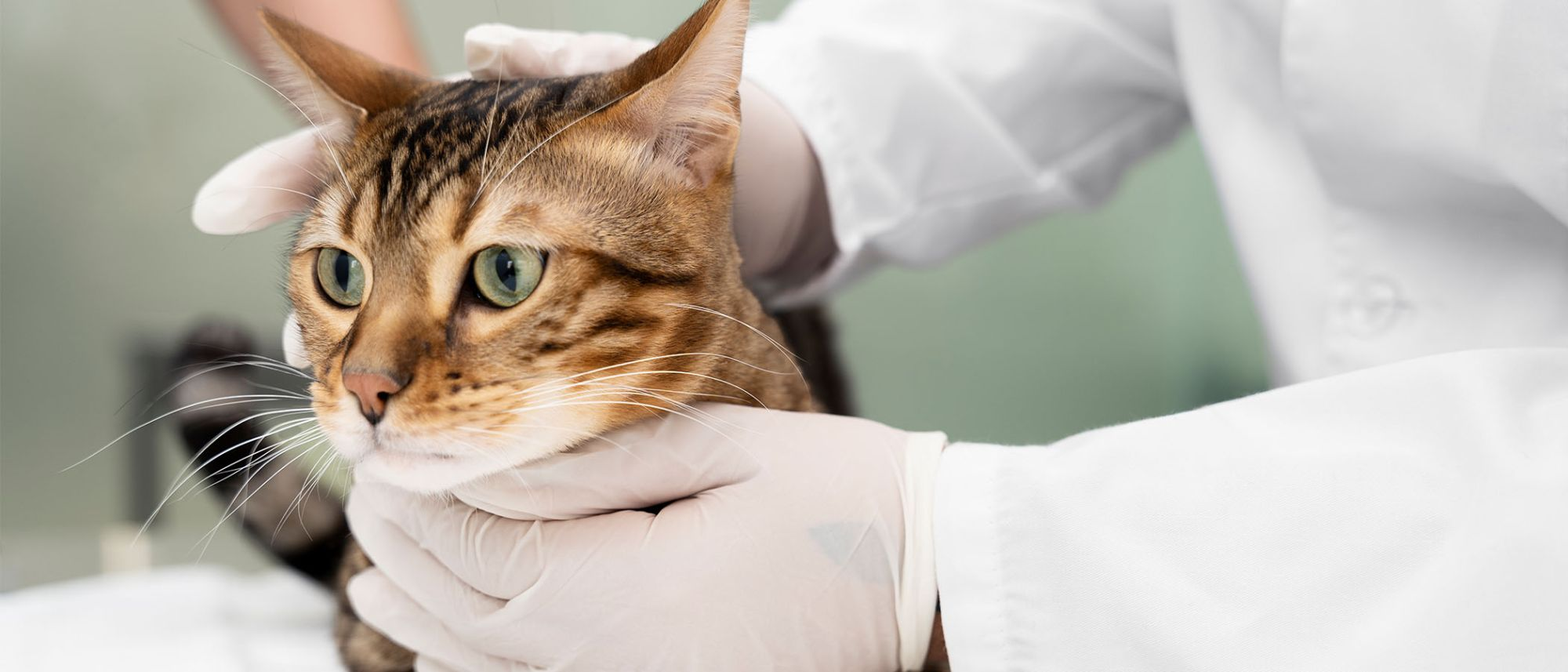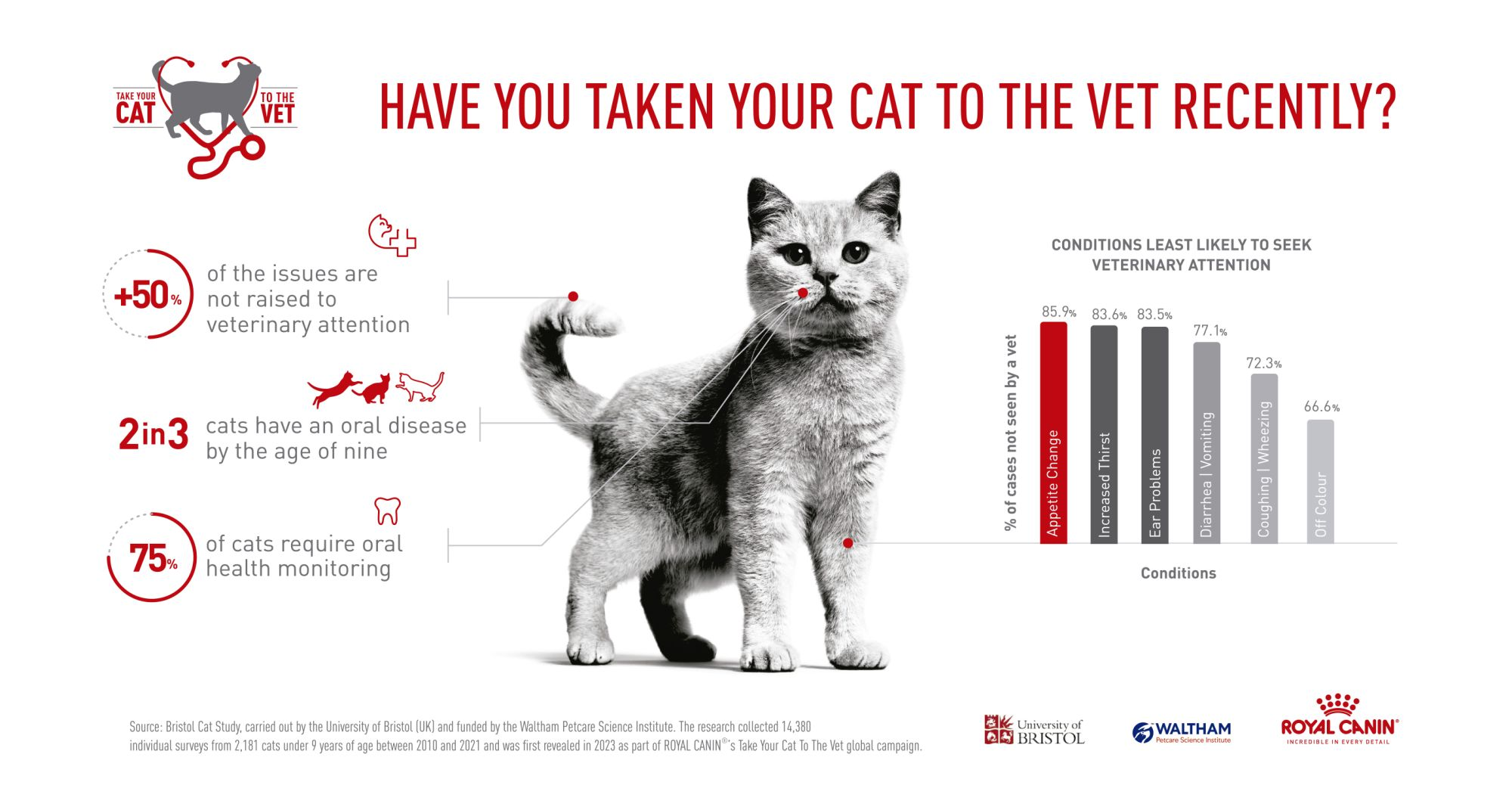Study reveals that veterinary attention is not sought for over 50% of cat health issues

- Veterinary attention is not sought for over 50% of cat health issues
- ¾ of cats required oral health monitoring at least once before turning 9
- Two in three cats are affected by oral disease by the age of 9
For International Cat Day, celebrated on August 8th, ROYAL CANIN® is reviewing brand new data from a study carried out by the University of Bristol in partnership with Waltham Petcare Science Institute1. The research is the first of its kind in the UK and is part of ROYAL CANIN®’s Take Your Cat To The Vet campaign, aiming to create and share knowledge with owners on the need to take their cats to the vet for them to live a healthy and happy life.
An ambitious survey
Ever since it was founded in 1968 by Dr. Jean Cathary, ROYAL CANIN® has been on a mission to promote pet health through nutrition and responsible ownership. The Take Your Cat To The Vet campaign has been raising awareness of the importance of regular veterinary check-ups to promote feline health. The initiative also supports pet professionals in adopting cat-friendly practices2 to better welcome these animals. For the 9th edition of this campaign, ROYAL CANIN® is proud to unveil a study held by the University of Bristol and funded by the Waltham Petcare Science Institute that focuses on cat health and highlights the importance of regular visits to the vet. The study collected 14,380 individual surveys from 2,181 cats under 9 years of age between 2010 and 2021. This was an unprecedented study, with the largest ever cat cohort in the UK and gathering real-life data by entering for the first time into cats’ homes, sourcing data directly from the owner, rather than strictly focusing on the veterinarian’s clinical data. It allowed the study to showcase what veterinarians see and, most importantly, what they do not get to see.
Veterinary attention is not sought for over 50% of the issues
Cats are masters of disguise and show pain differently than humans or even dogs, thus highlighting the importance of regular health monitoring. Veterinary attention is not sought for over 50% of the issues1 in part because owners perceived the issues as mild or recurring conditions and did not feel they were serious enough to require veterinary attention.
Among the most common issues not leading to a vet check-up are appetite change, increased thirst, vomiting, or diarrhea and whilst some of these may be the result of a mild self-limiting condition, they may indicate a more serious disease. For example, increased thirst is a common clinical sign of diseases such as feline hyperthyroidism, which can prove life-threatening if undetected.
These numbers show the importance of sharing knowledge with pet owners on the importance of seeking a veterinarian’s attention regularly for issues that might be overlooked due to the secretive nature of cats.
3/4 of cats required oral health monitoring
Growing cats see their oral health decline over time, but only 6.7% of the respondents' cats under 9 years old are undergoing dental work1. Standing from the veterinarians' point of view, particular attention should be provided to cats’ oral health monitoring because disease prevalence and severity increase with age1. A regular veterinary examination can help to identify potential oral health issues at an early stage.

Building adapted clinics
Although finances might be deterring pet owners from making routine visits to their veterinary practice, the experience itself may also be a barrier to regular visits. Among the reasons evoked by pet owners for not going to the vet, around 25% think it is a stressful event3. On the other hand, two-thirds said they would go more often if it were easier3.
Based on these findings, ROYAL CANIN® is working hand-in-hand with clinics to help them adopt cat-friendly practices, which reduces stress for everyone involved in a vet consultation: cats, owners, and veterinarians. This includes, for instance, creating dedicated spaces in waiting rooms for cats, training employees on how to handle anxious cats, and equipping vet offices with elevated structures for cat carriers since cats feel safer in high places. In addition, educational content and clinic certification programs developed by the American Association of Feline Practitioners (AAFP) and the International Society of Feline Medicine (ISFM) - that echo the Take Your Cat To The Vet campaign - offer great support to cat professionals, as they upskill veterinarians and technicians worldwide through certifications programs that prepare clinical staff to welcome feline patients.
Dr. Tanya Schoeman, Veterinary Specialist Physician and Royal Canin Feline Health Specialist, reinforces that “there can be various reasons why some cat owners do not take their cats to the vet regularly or at all. Some owners may believe that their cats are healthy and don't require medical attention unless they show visible signs of illness. This can be difficult to recognize in cats, as these animals are masters of disguise and often manage to hide their symptoms of underlying disease. Cat owners are often reluctant to take their cats to the vet - clients often state the difficulty of getting the cat into a carrier at home, driving to the clinic, and dealing with the stressed and fearful cat at the veterinary clinic as reasons for fewer visits4. That’s why educating and preparing the client and the veterinary team about respectful feline handling is necessary to avoid stress and accomplish the goal of good health care. It is essential to emphasize the importance of regular veterinary check-ups and preventive care for cats. Regular visits can help detect health issues early, ensure vaccinations are up-to-date, and provide proper guidance on diet and overall well-being”.
Olivier Reymond, Vice-President of Corporate Affairs & Vet Business at Royal Canin, said: “Through this 9th edition of Take Your Cat To The Vet campaign, ROYAL CANIN® is reaffirming once again its commitment to reconcile cats and veterinary clinics. It is more important than ever to keep fostering the collaboration between the owners and the vets to improve cats’ welfare and minimize health risks. It is our role as professionals and for cats’ sake to collaborate and to educate people on health conditions and how to deal with them, within a common Purpose: A BETTER WORLD FOR PETS”.
For more information and tips on stress-free vet visits for cat owners and cats or to learn more about ROYAL CANIN®, please visit RoyalCanin.com. You can also join the conversation on social media by using #TakeYourCatToTheVet, #Cat2Vet, #Kitten2Vet, and #TakeYourKittenToTheVet.
1Study held by the University of Bristol and funded by the Waltham Petcare Science Institute along with Cats Protection. Learn more at: http://www.bristol.ac.uk/vet-school/research/projects/cats.
2To learn more: https://catfriendlyclinic.org.
3Source: Study of 4437 cat primary care globally on cat owners' relationship with their vets (SKY agency, 2018).
4Reference: Hoyumpa A, Rodan I, Brown M, et al. AAFP-AAHA Feline Life Stage Guidelines. J Feline Med Surg 2010; 12: 43–54 Crossref. PubMed. ISI.
ABOUT ROYAL CANIN®
ROYAL CANIN® is part of the Royal Canin Division in the Mars, Incorporated group, and a global leader in Health Through Nutrition for cats and dogs fulfilling its Purpose: A BETTER WORLD FOR PETS. Founded in 1968 by French veterinarian, Dr. Jean Cathary, ROYAL CANIN® designs precise, science-based nutrition for cats and dogs available at pet specialty retailers and veterinary practices worldwide. Over the years, ROYAL CANIN® has pushed the limits of nutrition and knowledge in collaboration with pet professionals, including breeders and veterinarians. Its unique business approach puts the nutritional requirements of cats and dogs at the heart of innovation. Pet’s age, lifestyle, size, breed, and sensitivities are studied through science and observation to produce diets that meet their specific needs. ROYAL CANIN® generates value not only for pets but also for people and the planet. This means being mutually beneficial to the ecosystem, empowering Associates, building enduring relationships with stakeholders, and always thinking about how to ensure a viable future for generations to come. To learn more about ROYAL CANIN®, visit www.royalcanin.com.
ABOUT WALTHAM PETCARE SCIENCE INSTITUTE
Waltham is the science centre for Mars Petcare. Our research teams work across multiple disciplines, such as nutrient requirements for pets, the dog and cat microbiome, biomarkers of health and disease, and feeding behaviour. We also support research in partnership with organisations around the world to understand how our relationship with pets can help both pets and their owners to live healthy, happy lives together. The knowledge generated at Waltham is vital in bringing to life the Mars Petcare Purpose: A BETTER WORLD FOR PETS. We take pride in sharing our key findings with the scientific community, enabling pets around the world to benefit from our work. Since our first scientific paper over 50 years ago, we have shared our expertise through over 1700 publications, including more than 600 peer-reviewed journal articles. In addition, our researchers collaborate with some of the world’s most renowned veterinary and nutrition scientists. Find out more at waltham.com.
ABOUT THE UNIVERSITY OF BRISTOL
The University of Bristol is ranked within the top 10 universities in the UK and 55th in the world (QS World University Rankings 2024); it is also ranked among the top five institutions in the UK for its research, according to an analysis of the Research Excellence Framework (REF) 2021; and is the 4th most targeted university by top UK employers. The University was founded in 1876 and was granted its Royal Charter in 1909. It was the first university in England to admit women on the same basis as men. The University is a major force in the economic, social, and cultural life of Bristol and the region, but is also a significant player on the world stage. It has over 20,000 undergraduates and over 7,000 postgraduate students from more than 150 countries, and its research links span the globe.
Like & share this page